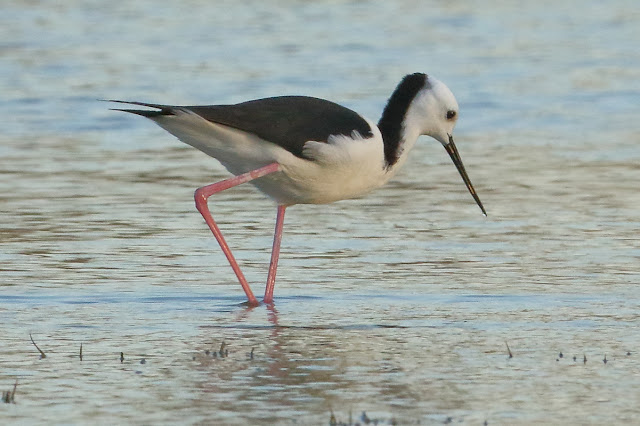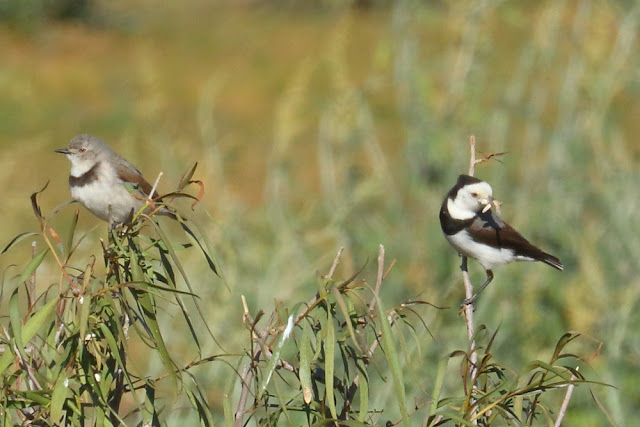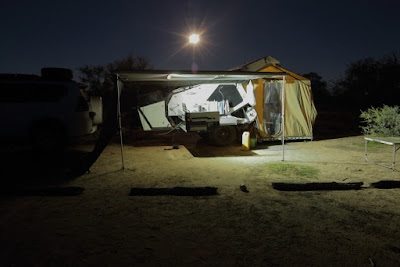Emu Dromaius novaehollandiae
Plumed Whistling-Duck Dendrocygna eytoni
Greylag Goose Domestic type Anser anser
Australian Shelduck Tadorna tadornoides
Muscovy Duck Domestic type Cairina moschata
Australian Wood Duck Chenonetta jubata
Australasian Shoveler Spatula rhynchotis
Pacific Black Duck Anas superciliosa
Grey Teal Anas gracilis
Chestnut Teal Anas castanea
Pink-eared Duck Malacorhynchus membranaceus
Hardhead Aythya australis
Australian Brushturkey Alectura lathami
Orange-footed Scrubfowl Megapodius reinwardt
Brown Quail Synoicus ypsilophorus
Australasian Grebe Tachybaptus novaehollandiae
Rock Dove Columba livia
Spotted Dove Streptopelia chinensis
Common Bronzewing Phaps chalcoptera
Crested Pigeon Ocyphaps lophotes
Spinifex Pigeon Geophaps plumifera
Diamond Dove Geopelia cuneata
Peaceful Dove Geopelia placida
Bar-shouldered Dove Geopelia humeralis
Australian Bustard Ardeotis australis
Pheasant Coucal Centropus phasianinus
Horsfield's Bronze-Cuckoo Chrysococcyx basalis
Little Bronze-Cuckoo Chrysococcyx minutillus
Pallid Cuckoo Cacomantis pallidus
Fan-tailed Cuckoo Cacomantis flabelliformis
Brush Cuckoo Cacomantis variolosus
Spotted Nightjar Eurostopodus argus
Australian Owlet-nightjar Aegotheles cristatus
Australian Swiftlet Aerodramus terraereginae
Australian Spotted Crake Porzana fluminea
Dusky Moorhen Gallinula tenebrosa
Eurasian Coot Fulica atra
Australasian Swamphen Porphyrio melanotus
Baillon's Crake Zapornia pusilla
Spotless Crake Zapornia tabuensis
Brolga Antigone rubicunda
Bush Stone-curlew Burhinus grallarius
Pied Stilt Himantopus leucocephalus
Banded Lapwing Vanellus tricolor
Masked Lapwing Vanellus miles
Red-capped Plover Charadrius ruficapillus
Red-kneed Dotterel Erythrogonys cinctus
Black-fronted Dotterel Elseyornis melanops
Comb-crested Jacana Irediparra gallinacea
Little Buttonquail Turnix velox
Silver Gull Chroicocephalus novaehollandiae
Gull-billed Tern Gelochelidon nilotica
Caspian Tern Hydroprogne caspia
Australasian Darter Anhinga novaehollandiae
Little Pied Cormorant Microcarbo melanoleucos
Great Cormorant Phalacrocorax carbo
Little Black Cormorant Phalacrocorax sulcirostris
Australian Pelican Pelecanus conspicillatus
White-necked Heron Ardea pacifica
Great-billed Heron Ardea sumatrana
Great Egret Ardea alba
Intermediate Egret Ardea intermedia
White-faced Heron Egretta novaehollandiae
Cattle Egret Bubulcus ibis
Nankeen Night-Heron Nycticorax caledonicus
Australian White Ibis Threskiornis molucca
Straw-necked Ibis Threskiornis spinicollis
Royal Spoonbill Platalea regia
Yellow-billed Spoonbill Platalea flavipes
Black-shouldered Kite Elanus axillaris
Black-breasted Buzzard Hamirostra melanosternon
Pacific Baza Aviceda subcristata
Little Eagle Hieraaetus morphnoides
Wedge-tailed Eagle Aquila audax
Spotted Harrier Circus assimilis
Collared Sparrowhawk Accipiter cirrocephalus
Black Kite Milvus migrans
Whistling Kite Haliastur sphenurus
Brahminy Kite Haliastur indus
White-bellied Sea-Eagle Haliaeetus leucogaster
Barn Owl Tyto alba
Barking Owl Ninox connivens
Southern Boobook Ninox novaeseelandiae
Laughing Kookaburra Dacelo novaeguineae
Blue-winged Kookaburra Dacelo leachii
Red-backed Kingfisher Todiramphus pyrrhopygius
Forest Kingfisher Todiramphus macleayii
Rainbow Bee-eater Merops ornatus
Nankeen Kestrel Falco cenchroides
Australian Hobby Falco longipennis
Brown Falcon Falco berigora
Red-tailed Black-Cockatoo Calyptorhynchus banksii
Major Mitchell's Cockatoo Lophochroa leadbeateri
Galah Eolophus roseicapilla
Little Corella Cacatua sanguinea
Sulphur-crested Cockatoo Cacatua galerita
Cockatiel Nymphicus hollandicus
Australian King-Parrot Alisterus scapularis
Red-winged Parrot Aprosmictus erythropterus
Bourke's Parrot Neophema bourkii
Blue-winged Parrot Neophema chrysostoma
Australian Ringneck Barnardius zonarius
Pale-headed Rosella Platycercus adscitus
Greater Bluebonnet Northiella haematogaster
Red-rumped Parrot Psephotus haematonotus
Mulga Parrot Psephotus varius
Budgerigar Melopsittacus undulatus
Rainbow Lorikeet Trichoglossus haematodus
Scaly-breasted Lorikeet Trichoglossus chlorolepidotus
Spotted Bowerbird Chlamydera maculata
Great Bowerbird Chlamydera nuchalis
Brown Treecreeper Climacteris picumnus
Rusty Grasswren Amytornis rowleyi
Thick-billed Grasswren Amytornis modestus
Eyrean Grasswren Amytornis goyderi
Rufous-crowned Emuwren Stipiturus ruficeps
Purple-backed Fairywren Malurus assimilis
Splendid Fairywren Malurus splendens
White-winged Fairywren Malurus leucopterus
Red-backed Fairywren Malurus melanocephalus
Yellow-spotted Honeyeater Meliphaga notata
Graceful Honeyeater Meliphaga gracilis
Yellow Honeyeater Stomiopera flava
White-gaped Honeyeater Stomiopera unicolor
White-fronted Honeyeater Purnella albifrons
Yellow-faced Honeyeater Caligavis chrysops
Noisy Miner Manorina melanocephala
Yellow-throated Miner Manorina flavigula
Spiny-cheeked Honeyeater Acanthagenys rufogularis
Singing Honeyeater Gavicalis virescens
White-plumed Honeyeater Ptilotula penicillata
Grey-headed Honeyeater Ptilotula keartlandi
Crimson Chat Epthianura tricolor
White-fronted Chat Epthianura albifrons
Black Honeyeater Sugomel nigrum
Brown Honeyeater Lichmera indistincta
White-eared Honeyeater Nesoptilotis leucotis
Blue-faced Honeyeater Entomyzon cyanotis
Black-chinned Honeyeater Melithreptus gularis
Striped Honeyeater Plectorhyncha lanceolata
Painted Honeyeater Grantiella picta
Little Friarbird Philemon citreogularis
Helmeted Friarbird Philemon buceroides
Noisy Friarbird Philemon corniculatus
Spotted Pardalote Pardalotus punctatus
Red-browed Pardalote Pardalotus rubricatus
Striated Pardalote Pardalotus striatus
Buff-rumped Thornbill Acanthiza reguloides
Inland Thornbill Acanthiza apicalis
Yellow-rumped Thornbill Acanthiza chrysorrhoa
Chestnut-rumped Thornbill Acanthiza uropygialis
Slaty-backed Thornbill Acanthiza robustirostris
Yellow Thornbill Acanthiza nana
Weebill Smicrornis brevirostris
White-throated Gerygone Gerygone olivacea
Large-billed Gerygone Gerygone magnirostris
Southern Whiteface Aphelocephala leucopsis
Grey-crowned Babbler Pomatostomus temporalis
Hall's Babbler Pomatostomus halli
Chestnut-crowned Babbler Pomatostomus ruficeps
Eastern Whipbird Psophodes olivaceus
Chiming Wedgebill Psophodes occidentalis
Chirruping Wedgebill Psophodes cristatus
Spotted Quail-thrush Cinclosoma punctatum
Chestnut-br.Quail-thrush Cinclosoma castaneothorax
Cinnamon Quail-thrush Cinclosoma cinnamomeum
White-breasted Woodswallow Artamus leucorynchus
Masked Woodswallow Artamus personatus
White-browed Woodswallow Artamus superciliosus
Black-faced Woodswallow Artamus cinereus
Dusky Woodswallow Artamus cyanopterus
Little Woodswallow Artamus minor
Grey Butcherbird Cracticus torquatus
Pied Butcherbird Cracticus nigrogularis
Black Butcherbird Cracticus quoyi
Australian Magpie Gymnorhina tibicen
Pied Currawong Strepera graculina
Black-faced Cuckooshrike Coracina novaehollandiae
White-bellied Cuckooshrike Coracina papuensis
White-winged Triller Lalage tricolor
Varied Triller Lalage leucomela
Varied Sittella Daphoenositta chrysoptera
Grey Shrikethrush Colluricincla harmonica
Little Shrikethrush Colluricincla megarhyncha
Rufous Whistler Pachycephala rufiventris
Crested Bellbird Oreoica gutturalis
Olive-backed Oriole Oriolus sagittatus
Yellow Oriole Oriolus flavocinctus
Australasian Figbird Sphecotheres vieilloti
Spangled Drongo Dicrurus bracteatus
Willie Wagtail Rhipidura leucophrys
Grey Fantail Rhipidura albiscapa
Spectacled Monarch Symposiachrus trivirgatus
Magpie-lark Grallina cyanoleuca
Leaden Flycatcher Myiagra rubecula
Restless Flycatcher Myiagra inquieta
Torresian Crow Corvus orru
Little Crow Corvus bennetti
Australian Raven Corvus coronoides
White-winged Chough Corcorax melanorhamphos
Apostlebird Struthidea cinerea
Victoria's Riflebird Ptiloris victoriae
Jacky Winter Microeca fascinans
Red-capped Robin Petroica goodenovii
Hooded Robin Melanodryas cucullata
Welcome Swallow Hirundo neoxena
Fairy Martin Petrochelidon ariel
Tree Martin Petrochelidon nigricans
Fairy/Tree Martin Petrochelidon ariel/nigricans
White-backed Swallow Cheramoeca leucosterna
Australian Reed Warbler Acrocephalus australis
Little Grassbird Megalurus gramineus
Brown Songlark Megalurus cruralis
Rufous Songlark Megalurus mathewsi
Silvereye Zosterops lateralis
Metallic Starling Aplonis metallica
Common Myna Acridotheres tristis
Mistletoebird Dicaeum hirundinaceum
Olive-backed Sunbird Cinnyris jugularis
Australasian Pipit Anthus novaeseelandiae
House Sparrow Passer domesticus
Plum-headed Finch Neochmia modesta
Zebra Finch Taeniopygia guttata
223 Species















































































































































































































